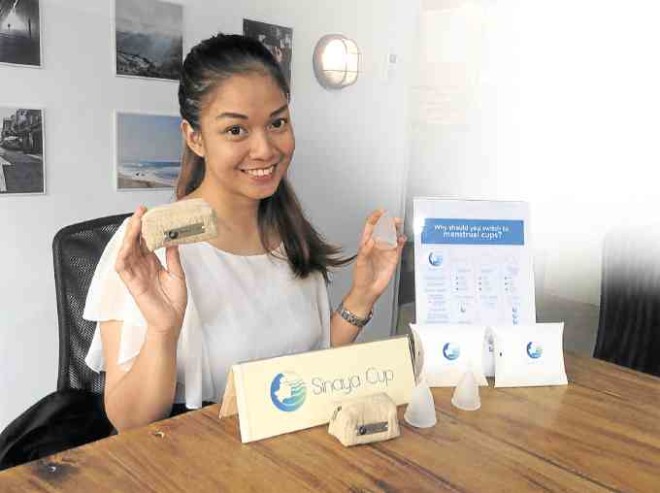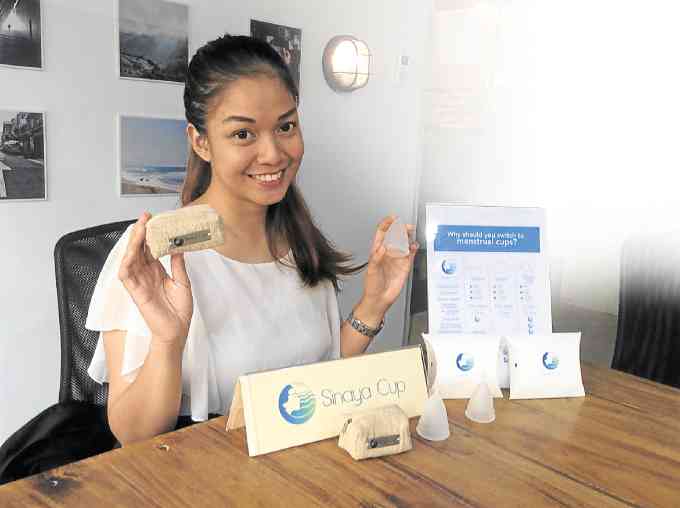
menstrual cups
Remember Olympic swimmer Fu Yuanhui, who earned praise for breaking a big taboo? She talked about her period on national TV, frankly.
Menstruation is one thing women should talk about. In the Philippines, where pads are in and tampons are quite unheard of, a menstrual cup might be a bit alienating—at first.
A menstrual cup is a bell-shaped feminine hygiene product made of medical-grade silicone. It is biocompatible, and nonreactive to body tissues and fluids. It is soft, flexible and worn inside the vagina to collect menstrual blood for disposal later on.
Menstrual cups first appeared in the west in the 1930s, but were not a commercial success at that time. Today, a lot of brands are making waves in the global feminine hygiene market.
For Audrey Tangonan, 27, this could be something new for Filipino women with the rise of Sinaya Cup, the first local brand in the market.
Starting the menstrual cup business in 2015, Tangonan believes in women empowerment and protecting the environment at the same time. For her, monthly periods should not hinder modern Filipino women who want to achieve the peak moments of life.
“We really want women to take charge of their bodies, their menstruation, and do things that they couldn’t do before when they had their period,” Tangonan shares.
Unlike pads and tampons, menstrual cups are waterproof, and can be used for diving, swimming and surfing. They are perfect for Filipino women with active lifestyles, says Tangonan.
Sustainable
Menstrual cups come in different colors, sizes, and “stems.” They are soft, flexible and sustainable. The cup must be folded in a shape that would best fit while being inserted in a woman’s vaginal canal.
Tangonan demonstrated two kinds of folds: the C-fold (folding the cup just like the letter C) and the push-down fold (pressing down the rim of the cup to the center, inside forming a triangular shape).
Some situations require techniques like rotating, twisting and pinching the base of the cup to “tuck it in the right place.” Once released inside, “the cup will pop open, creating a seal within the vaginal walls.” It is reusable and can last for years, but replacement every year is advised.
Menstrual cups can withstand high temperatures because of their properties, and “must be boiled before usage at the start of the user’s cycle for proper sanitation.”
It might be challenge for women to try a menstrual cup. For first timers, there’s a learning curve, and it might take a number of periods before they get the hang of this internal device.
According to Tangonan, using a menstrual cup might also save someone from Toxic Shock Syndrome, a life-threatening illness caused by bacteria-mediated infection.

Asked about safety, Tangonan guaranteed that their products are also ISO- and FDA-approved, like other brands. Apart from that, they also promote the “buy one, give one” promo. But, initial investment should also be considered.
Sheila Mendoza, 37, switched from pads to menstrual cups two months ago. She made the choice due to heavy periods, plus the cramps which she suffers from. She bought from an online local store and tried a foreign brand.
Novel experience
As a neophyte, she admits she is still getting the hang of it, the feeling of wearing something “down there.”
“It took a bit of getting used to. Like I mentioned, I don’t like tampons so I’ve never tried using them. So, the act of inserting something foreign was a novel experience,” she adds.
For Mendoza, the use of menstrual cups is also a great alternative to reduce waste, help the environment and cut the cost of monthly periods. But menstrual cups, like any other products, have limitations.
Mendoza found out that it doesn’t help with cramps, so she’s experiencing difficulty when trying to insert it. Boiling the product is also a hassle at times, which is why she usually goes back to pads when in a hurry. Also, one should buy the right size to avoid leakage.
But for Mendoza, it’s not too late to educate oneself on using the product. Every woman should learn her body’s anatomy to adapt. “It can be a bit icky in the beginning, but I think the benefits outweigh all that. I say get one and do it for Mother Nature,” Mendoza shares.
Sinaya Cup is in partnership with Days for Girls, an international women’s advocacy group, to distribute washable pads and try to introduce menstrual cups to school girls from poverty-stricken communities in the Philippines through their “buy one, give one” company promotion. Through this initiative, Tangonan believes change is coming to a lot of Filipina women.
“Men and women are equal; you can compete in the same playing field. You just need to have the right tool to level that field.”
Visit Sinaya Cup on Facebook.









































